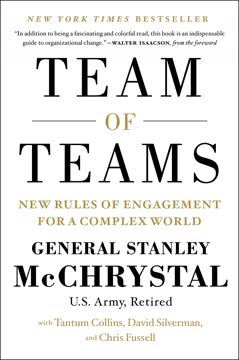Key Takeaways
1. Evolutionary-Teal: A new paradigm for organizational consciousness
Einstein once famously said that problems couldn't be solved with the same level of consciousness that created them in the first place.
Stages of organizational evolution. Organizations, like human consciousness, have evolved through distinct stages: Impulsive-Red (constant exercise of power), Conformist-Amber (highly formal roles and hierarchies), Achievement-Orange (innovation and accountability), and Pluralistic-Green (empowerment and values-driven culture). Evolutionary-Teal represents the next stage, characterized by self-management, wholeness, and evolutionary purpose.
Teal characteristics. Teal organizations operate on trust rather than fear, viewing people as fundamentally worthy and capable. They embrace complexity and uncertainty, focusing on sensing and responding rather than predicting and controlling. This paradigm shift allows for more authentic, purposeful, and adaptive organizations that can better address the challenges of our time.
2. Self-management: Transcending hierarchy for distributed power
With no scarce promotions to fight for, no bosses to please, and no adversaries to elbow aside, much of the political poison is drained out of organizations.
Distributed authority. Self-management replaces traditional hierarchies with fluid, peer-based structures. Decision-making is decentralized through practices like the "advice process," where anyone can make decisions after seeking input from affected parties and experts.
Organic adaptation. Without fixed job descriptions or titles, roles evolve naturally based on skills and organizational needs. This flexibility allows for rapid adaptation to changing circumstances and fosters innovation.
- Teams are typically small (10-20 people) and largely self-governing
- Staff functions are minimized, with most responsibilities handled within teams
- Coordination happens through ad-hoc meetings and voluntary task forces
3. Wholeness: Embracing our full selves at work
Life wants to happen. Life is unstoppable. Anytime we try and contain life, or interfere with its fundamental need for expression, we get into trouble.
Beyond the professional mask. Teal organizations strive to create environments where people can bring their whole selves to work – rational, emotional, intuitive, and spiritual. This fosters deeper connections, creativity, and engagement.
Practices for wholeness:
- Reflective spaces: meditation rooms, team supervision, peer coaching
- Storytelling: personal sharing in meetings, company-wide events
- Conflict resolution: clearly defined processes for addressing disagreements
- Office design: spaces that feel more like home than traditional workplaces
4. Evolutionary purpose: Organizations as living entities with their own direction
Trying to predict and control the future is futile. We make forecasts only when a specific decision requires us to do so.
Purpose over profit. Teal organizations view themselves as having their own evolutionary purpose, distinct from maximizing shareholder value. Leaders and employees see their role as stewards, listening and responding to the organization's emergent direction.
Organic strategy. Instead of top-down strategic planning, strategy emerges organically from the collective intelligence of self-managing employees. This allows for:
- Rapid adaptation to market changes
- Innovation driven by purpose rather than solely by profit
- Increased employee engagement through connection to a meaningful purpose
5. Teal practices: Concrete ways to implement new organizational structures
Self-management, just like the traditional pyramidal model it replaces, works with an interlocking set of structures, processes, and practices.
Reinventing core processes. Teal organizations reimagine fundamental business practices to align with self-management, wholeness, and evolutionary purpose:
- Recruitment: Focus on cultural fit and alignment with purpose
- Onboarding: Extensive training in self-management and organizational values
- Performance management: Peer-based feedback and self-set goals
- Compensation: Often determined through peer-based processes
- Budgeting and control: Minimal forecasting, trust-based spending
- Change management: Continuous, organic evolution rather than top-down initiatives
6. Leadership in Teal: Creating and maintaining space for new ways of operating
The general rule seems to be that the level of consciousness of an organization cannot exceed the level of consciousness of its leader.
Holding the space. Teal leaders play a crucial role in creating and maintaining an environment where self-management, wholeness, and evolutionary purpose can thrive. This involves:
- Consistently reinforcing Teal principles when traditional practices creep in
- Role-modeling vulnerability, authenticity, and trust in the process
- Resisting the urge to impose control or make top-down decisions
Paradoxical importance. While Teal leaders have less direct power, their presence and commitment to Teal principles are essential for the organization to operate at this level of consciousness.
7. Transitioning to Teal: Necessary conditions and practical steps for transformation
What makes us leave so much of our selfhood behind when we go to work? There is a conspiracy of fears at play that involves employees as much as their organizations.
Key prerequisites:
- CEO alignment: The top leader must deeply understand and embrace Teal principles
- Board support: Owners/board members need to support the Teal approach
Transformation process:
- Start with one breakthrough (self-management, wholeness, or evolutionary purpose) and introduce others over time
- Expect resistance, especially from middle management and staff functions
- Foster psychological ownership among employees through purpose, peer emulation, and market pressure
- Implement new practices gradually, allowing time for adaptation and learning
Ongoing evolution. Transitioning to Teal is not a one-time event but an ongoing process of sensing and responding to the organization's needs and purpose.
Last updated:
FAQ
What's Reinventing Organizations about?
- Organizational Evolution: The book explores the evolution of human consciousness and its impact on organizational models, highlighting the shift from traditional hierarchies to "Teal" organizations.
- Teal Organizations: These are defined by principles of self-management, wholeness, and evolutionary purpose, aiming to create environments where individuals can thrive.
- Practical Examples: Frederic Laloux provides case studies of organizations that have successfully implemented Teal principles, illustrating their effectiveness and differences from conventional management practices.
Why should I read Reinventing Organizations?
- Innovative Perspective: The book challenges traditional organizational structures, offering a fresh perspective on management that can lead to increased engagement and efficiency.
- Real-World Examples: It includes numerous case studies, making the concepts relatable and applicable across various sectors.
- Guidance for Change: For leaders and change agents, it serves as a practical guide to transitioning from traditional models to more evolved organizational structures.
What are the key takeaways of Reinventing Organizations?
- Three Breakthroughs: The book identifies self-management, wholeness, and evolutionary purpose as key breakthroughs for Teal organizations.
- Self-Management: Empowering teams to make decisions collectively without hierarchical oversight leads to increased engagement and accountability.
- Wholeness and Purpose: Encouraging employees to bring their whole selves to work fosters authenticity, while focusing on purpose transcends profit motives.
How does Frederic Laloux define "Teal Organizations"?
- Evolutionary Stage: Teal Organizations represent a new stage in human consciousness, characterized by self-management, wholeness, and evolutionary purpose.
- Living Systems Metaphor: Laloux uses this metaphor to emphasize adaptability and organic growth, encouraging a holistic management approach.
- Collective Intelligence: These organizations leverage the collective intelligence of their members for effective problem-solving and innovation.
What is the concept of self-management in Reinventing Organizations?
- Decentralized Decision-Making: Teams make decisions without needing approval from higher-ups, fostering a sense of ownership and empowerment.
- Advice Process: Decisions are made by seeking input from affected parties, ensuring diverse perspectives are considered while maintaining accountability.
- Fluid Roles: Individuals can take on various responsibilities based on skills and interests, enhancing collaboration and innovation.
What is the role of evolutionary purpose in Reinventing Organizations?
- Guiding Direction: Evolutionary purpose serves as the underlying reason for an organization's existence, guiding actions beyond profit motives.
- Collective Intelligence: Organizations should listen to their purpose collectively, allowing all employees to contribute to its evolution.
- Alignment with Values: When purpose aligns with employee values, it fosters a sense of belonging and commitment, enhancing performance.
How do Teal Organizations handle decision-making?
- Advice Process: Decisions are made by consulting relevant stakeholders, ensuring diverse perspectives are considered.
- No Consensus Required: Unlike traditional models, decisions can be made without unanimous agreement, preventing paralysis and encouraging timely action.
- Empowerment and Responsibility: Individuals are empowered to make decisions, fostering ownership and accountability, leading to higher engagement.
What are some examples of Teal Organizations mentioned in Reinventing Organizations?
- Buurtzorg: A Dutch nursing organization with self-managing teams, focusing on holistic care and achieving high patient satisfaction.
- FAVI: A French brass foundry that empowers teams to make production decisions, resulting in high employee engagement and success.
- AES: A global energy provider that initially operated with self-managing teams, emphasizing trust and decentralized decision-making.
What challenges do organizations face when transitioning to a Teal model?
- Cultural Resistance: Resistance from employees accustomed to traditional structures requires strong leadership and a clear vision for change.
- Skill Development: Training in self-management and decision-making processes is crucial for a successful transition.
- Maintaining Trust: Building and maintaining trust is essential, requiring a culture that supports open communication and collaboration.
How does Reinventing Organizations define wholeness?
- Bringing Your Whole Self: Individuals should express all aspects of themselves at work, fostering authenticity and connection.
- Creating Safe Spaces: Environments where employees feel safe to be authentic lead to deeper connections and collaboration.
- Collective Growth: Encouraging wholeness allows the organization to thrive, as people are more engaged and motivated.
What are the implications of the advice process in Reinventing Organizations?
- Empowerment of Employees: The process empowers employees to take initiative and make decisions, fostering trust and collaboration.
- Diverse Perspectives: Seeking input from colleagues leads to better decision-making through a wider range of insights.
- Responsibility and Accountability: Individuals take responsibility for their choices, reinforcing accountability within the organization.
What are the necessary conditions for creating a Teal Organization?
- Leadership Alignment: Leaders must embrace self-management and purpose-driven practices consistent with the Teal paradigm.
- Supportive Ownership: Board members and owners must align with the Evolutionary-Teal perspective to sustain practices.
- Cultural Readiness: A culture open to change and new ways of working is essential for a smooth transition to Teal practices.
Review Summary
Reinventing Organizations receives mostly positive reviews, with readers praising its innovative approach to organizational management. Many find the book's ideas on self-management, wholeness, and evolutionary purpose inspiring and applicable. The illustrated version is appreciated for its accessibility and visual appeal. Some readers express skepticism about the practicality of implementing these concepts in all organizations. Critics note that the book may oversimplify complex issues and lack concrete implementation strategies. Overall, the book is seen as thought-provoking and potentially transformative for those open to new organizational paradigms.
Similar Books






Download PDF
Download EPUB
.epub digital book format is ideal for reading ebooks on phones, tablets, and e-readers.





